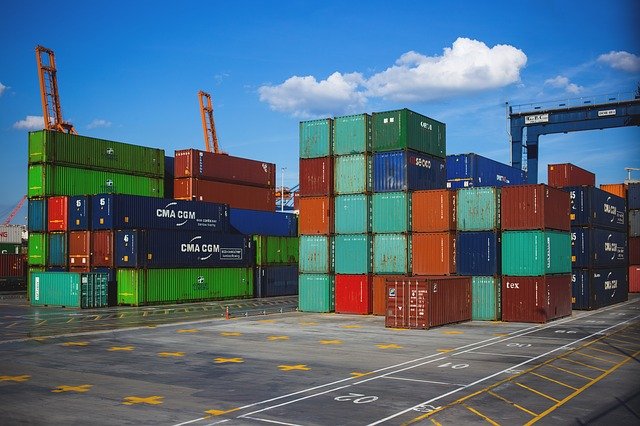 By
Molly
By
Molly
As a responsible business owner, you need to understand multiple aspects of your company, including the processes involved with shipping your products where they need to go. If your business needs to ship globally or internationally, freight shipping is an important concept to grasp. In this article, we’ll discuss what freight shipping is, various types of freight shipping, the process of freight shipping, costs involved, and other critical topics to help you become a more informed business professional.
What Exactly Is Freight Shipping?

Freight shipping is defined as the “conveyance of large quantities of various products and materials from one place to another by water, air, road, or rail.” Unlike last mile carriers, freight carriers typically transport goods long distances.
Not all shipments classify as freight. A small package you drop off at the post office, for example, does make sense to ship by freight. For a shipment to classify as freight, it must meet specific size and weight requirements; namely, dimensions of 30 by 30 by 30 inches or larger and a weight of 150 pounds or greater.
While some people may refer to “freight” and “shipping” interchangeably, they are two separate concepts. We’ll explain the difference below.
Difference Between Freight and Shipping
Essentially, “freight” is used to describe the shipments of goods that an entity or business needs to ship from one place to another. The process of transporting those shipments is what “shipping” is. Think of “freight” as the message and “shipping” as the messenger.
Freight vs. Shipping Products
Another key difference to understand is that of freight shipping vs. parcel shipping. Knowing how to distinguish between these two terms will help you choose when to use one instead of the other.
- Freight Shipping: This method can be more cost-efficient and less environmentally wasteful as it allows people to group shipments together. Freight shipping also includes a warehousing step between the sender and the recipient.
- Parcel Shipping: This method is more direct than freight, as it allows you to send an item directly to the recipient, but it is also more costly. Parcel shipping is more fitting for individual people and small businesses that don’t need to ship items in the same volume as larger businesses.

What Can Be Shipped via Freight?
If you can sell it, you will likely be able to ship it. Freight shipping can cover multiple types of goods and commodities, from lumber to food to dry goods. It is vital to find a carrier that can make accommodations, such as providing temperature control, for the items you intend to ship.
How Does It Work?
Now that we’ve covered the basics of, we’ll discuss the process of freight shipment from start to finish.
Accumulating Shipment Information
The first step in the freight process is to gather all the relevant details about the items you need to ship. This information is necessary for a smooth and hassle-free shipment. Details can include the weight of your items, how large they are, how many you are shipping, and what type of product you need to send.
Choosing the Right Shipping Method
Next, your job is to figure out whether to send your shipment by road, rail, plane, or ship. Shipments within the same country may require different mixes of shipping methods than international freight shipping.
Packing the Shipment
Proper packing is a hugely important step in the process because it will protect your items as they travel from location to location. Often, the preferred packing method is securing wrapped items to pallets.
Label Your Shipment
The accuracy of shipments depends on correct labeling. Your packages should be labeled in multiple places to provide as much information as possible to aid with transportation.
Finish the Bill of Lading
The final step is to complete the bill of lading. This document details any relevant information about the shipment, including the contents of the shipment, who is sending it, and who it’s being sent to. Both parties involved in a freight shipment should have copies of this document.
What Are the Options for Freight Shipping?
There are several options for freight shipping to accommodate the amount of product you need to ship, your budget, and your urgent needs. We’ll discuss them all here.
Full Truckload or FTL
Full Truckload, or FTL, shipping involves a truck with one single shipment. If your shipment is large enough, FTL shipping can be the most cost-effective option and result in a shorter transit and less chance of mishandled materials.
Less-than-Truckload or LTL
Less-than-truckload, or LTL, shipping means a truck will carry multiple shipments. LTL is more cost-effective for smaller loads.
Partial Truckload or PTL
Partial Truckload, or PTL, is the option between LTL and FTL. With PTL, the same truck will transport your items from starting point to destination, but the journey might be longer due to the multiple stops the truck needs to make.
Intermodal
Intermodal shipping involves shipping items by a mix of different methods, such as truck and ship, to cut down on costs. This option can require additional paperwork and a longer shipment time.
Expedited
For more urgent needs, there’s also expedited shipping, which uses various methods such as reduced stops to get products to their location in the least amount of time possible.
How Much Will Freight Shipping Cost?
Any smart business owner will wonder: “How much is freight shipping going to cost me?” There is no hard-and-fast answer for this, and prices will depend on multiple factors, including cargo transport methods, where the shipment is leaving from and where it’s going, the cargo’s size and weight, and any special handling needs. Your freight shipping class, which is a categorization system to determine tariff amounts, may also play a part in the cost of freight shipping.
Shipping Method
Different shipping methods are more or less cost-effective than others. International shipping may involve air travel, which is the costliest method.
Origin and Destination
It might go without saying, but the longer your cargo has to travel, the more you’ll likely have to pay to ship it by freight.
Weight and Dimensions
Heavier items and items that take up more space are also more expensive to ship.
Special Handling Services
Some freight shipments, such as those containing hazardous or temperature-sensitive materials, may require special handling, which can add additional costs.
Benefits of Freight Shipping
When your business shipments get large enough or complicated enough, freight shipping may be your best option. There are several key benefits to this type of shipping for you and your business.
High Quality
Freight carriers go to great lengths to ensure the responsible and safe transit of shipments. Parcel shipping can open up the possibility of lost or damaged goods, but the methods used in freight shipping minimize the chance of this.
Value for Money
When it comes to large, heavy shipments, freight shipping options will provide a better price, even if you don’t have enough cargo for an FTL shipment.
Immediate Delivery
While it comes with additional cost, expedited shipping is a great reason to choose freight for large shipments that need to make it to their destination in a short amount of time.
Choosing Your Freight Shipping Partner
Freight shipping is crucial to keep your international business running and growing. Working with a third-party logistics, or 3PL, company to help you manage your supply chain can be the smart partnership you need. 3PL partners manage a variety of supply chain tasks, ranging from printing to sourcing to design and distribution. Finding one partner to take care of all of your eCommerce needs is the most cost-efficient choice for your business.
Print Bind Ship for All Your Shipping Needs
If you need a reliable 3PL partner to help you scale your freight shipping and your business, reach out to Print Bind Ship. We ship to any location worldwide with a 24-hour turnaround and offer some of the industry’s most competitive prices. Request a quote for your business today.